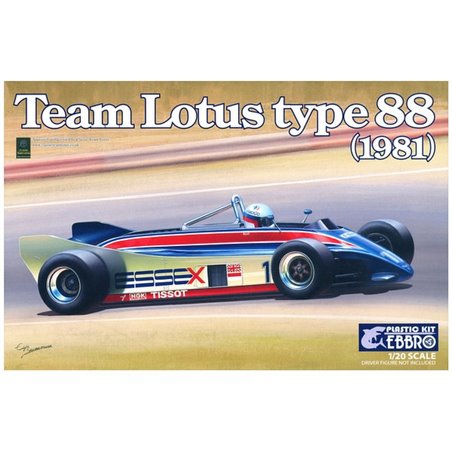





From the manufacturer:
Team Lotus pioneered te use of ground effect in the team's Type 78 and Type 79 racing cars. Type 80 followed in 1979, aiming to take even greater advantage of ground effect, only to experience severe "porpoising" or "bow bashing, " a phenomenon in which the car bounces up and down at the first bump on the road. As a solution to the problem, for 1980, Peter Wright came up with the idea of separating the monococque chassis from the downforce-creating body. Peter Wright and Martin Ogilvie thus builg the Type 86 test car on this principle, and discovered that it not only achieved tremendous downforce, but did so without showing any "porpoising." From this was born the Type 88 racing car.
Both Type 86 and 88 boast an outer sprung structure with independent springs to carry aerodynamic loads. Regulations required that any part having an aerodynamic influence had to be mounted to the entirely sprung part of the car. This in turn allowed to define the outer sprung body structure as part of the chassis, with the body structure defined as the primary chassis while the conventional inner chassis struture became the secondary chassis to create what the team called a twin-chassis construction.
For 1981, a new rule required at least 6cm of ground clearance at rest. The outer sprung primary chassis allowed to meet this new requirement at rest. Downforce at speed would then push the body down, further helping promote downforce. Tests with Type 86 showed that the traditional aluminum honeycomb structure was not strong enough to bear the increase in downforce. So for Type 88, the secondary chassis monocoque was made of nomex honeycomb sandwiched between kevlar-reinforced carbon fibre. Entirely developed by Team Lotus, it effectively became the first carbon composite monocoque in the history of Formula 1. It provided not only lighter, but stronger and safer than traditional aluminum honeycomb construction.
With good test results validating its performance, Type 88 was introduced at the 1981 Long Beach GP at the hands of Elio de Angelis. But despite having passed scrutineering, and practiced on Friday, it was forbidden to run the rest of the weekend. The story repeated itself at the Brazilian and Argentinian GPs where it was forbidden to race again and again. A further developed Type 88B was brought to the British GP, only to be forbidden to race by the FISA once again How Type 88 was not allowd to race even before it could show its potential is a sad story. But it shall be remembered as the car that introduced carbon composite monocoque construction to Formula 1, and as such an important step forward in the history of automotive engineering. In recent years, Type 88 has finally been able to prove its potential, if only in historic car events, showing to the world the fundamental rightness of the twin-chassis concept.
Molded in blue, gray, chrome and black plastic, with soft tires and decals.